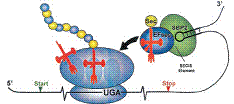Biochemistry, Department of

Vadim Gladyshev Publications
Document Type
Article
Date of this Version
January 2006
Abstract
The use of selenocysteine (Sec) as the 21st amino acid in the genetic code has been described in all three major domains of life. However, within eukaryotes, selenoproteins are only known in animals and algae. In this study, we characterized selenoproteomes and Sec insertion systems in protozoan Apicomplexa parasites. We found that among these organisms, Plasmodium and Toxoplasma utilized Sec, whereas Cryptosporidium did not. However, Plasmodium had no homologs of known selenoproteins. By searching computationally for evolutionarily conserved selenocysteine insertion sequence (SECIS) elements, which are RNA structures involved in Sec insertion, we identified four unique Plasmodium falciparum selenoprotein genes. These selenoproteins were incorrectly annotated in PlasmoDB, were conserved in other Plasmodia and had no detectable homologs in other species. We provide evidence that two Plasmodium SECIS elements supported Sec insertion into parasite and endogenous selenoproteins when they were expressed in mammalian cells, demonstrating that the Plasmodium SECIS elements are functional and indicating conservation of Sec insertion between Apicomplexa and animals. Dependence of the plasmodial parasites on selenium suggests possible strategies for antimalarial drug development.


Comments
Published in Nucleic Acids Research, 2006, Vol. 34, No. 2. © The Author 2006. Permission to use.